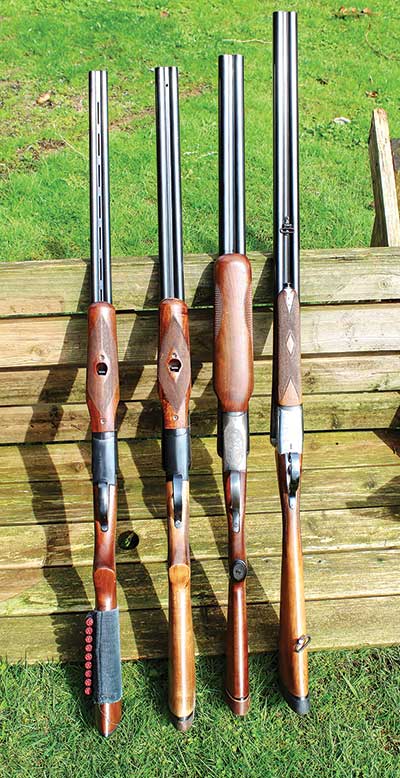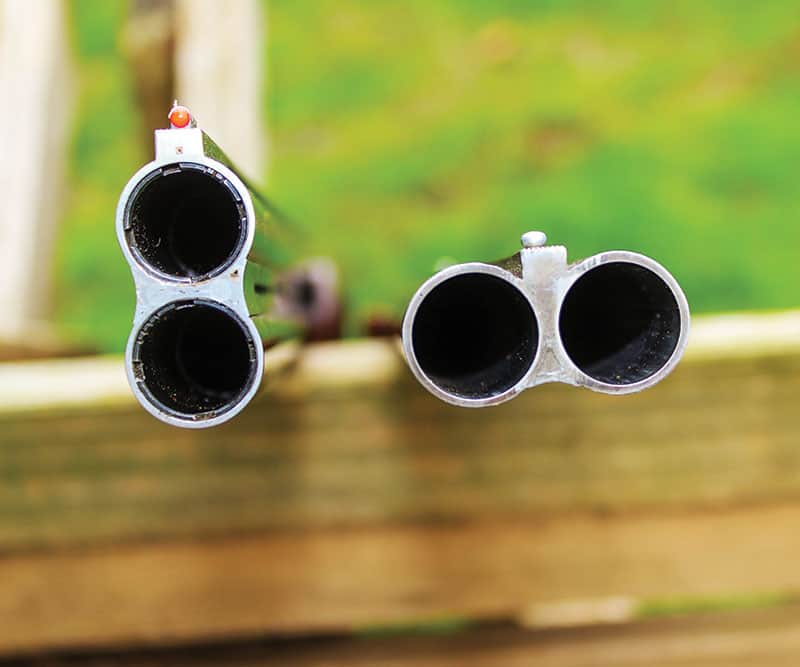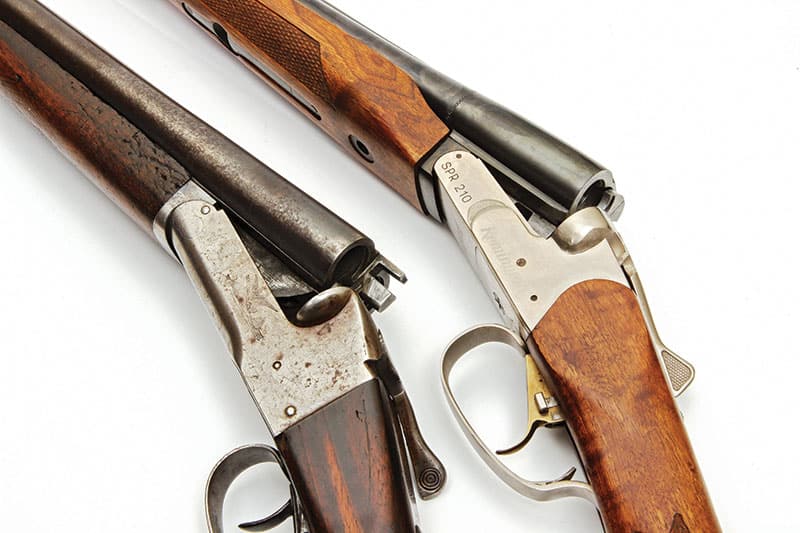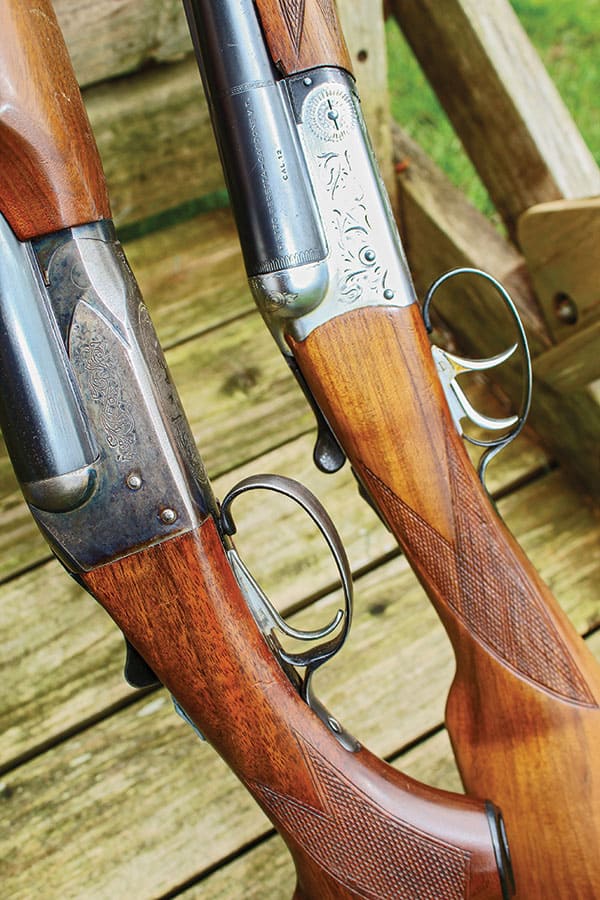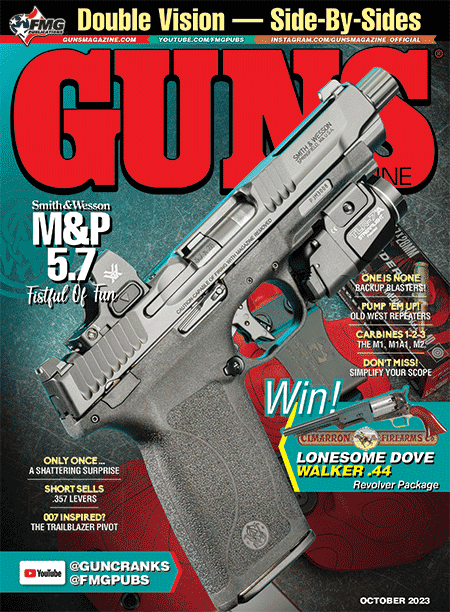Double Vision
Everybody Should Own A 2-Barrel Shotgun
Every upland bird hunter, whether his game is pheasants, grouse, quail, chukars or even wild turkey, ought to have at least one double-barrel shotgun. In my case, let’s just say I got carried away.
Perhaps it is because the twin-barrel shotgun has always been — at least in my estimation — a practical, reliable and frequently elegant fowling piece. In some variations, it has also served as an intimidating and necessarily lethal tool for law enforcement and armed citizens from frontier times to the present day.
Advantages
With comparable barrel lengths, double-barrel shotguns are typically lighter and shorter overall than either pumpguns or self-loaders because of their added receiver length and the weight of the internal mechanism. This is no small consideration if you’re tramping the scabrocks for chukars, quail or Hungarian partridge all day long.
In my opinion, nothing beats a double gun for quicker second shots. I’ve hunted with pumps and semi-autos and for me there is no comparison. Others may disagree.
One thing I learned early about side-by-side double-barrel shotguns is not everybody can adapt to them. Barrels are “regulated” — aligned in a way so patterns fired from right and left barrels (or top and bottom) cover one another at a certain distance from the muzzle, typically at 40 yards depending upon the gun. For .410 bore shotguns, the distance is more likely 25 yards.
Take a double to the range, set up patterning targets at 30 and 40 yards, and cut loose. It will soon become evident where your patterns come together.
For most of my game, I’ll use No. 5, 6 or 7 ½ shot. I watch for sales and stock up on ammunition, even if it’s in late winter or mid-summer (the “off-seasons”) because come fall, I won’t stand in line or stare at empty shelves. Each of those shot sizes is capable of bringing down the upland birds I prefer to hunt. If quail is the game, I can stick with the 7 ½ shot, and in the rare event I go after mourning dove, I’ll load up with No. 8 and take my chances.
A typical No. 6 Remington 2 ¾” 12-gauge payload will leave the muzzle between 1,300 fps and 1,400 fps depending upon the load. Winchester’s 12-gauge loads in 2 ¾” in No. 5 or 6 also clock around 1,300 fps. Federal offers a couple of 12-gauge 2 ¾” loads in No. 5 or 6 launching at 1,500 fps. Why I’m including this information is to remind you we’re talking about taking care of business, and any twin bore loaded with any of these loads will do the job, as I’ve managed many times.
My first 20-gauge was a used Stoeger Uplander S/S with double triggers, a plain-Jane finish, automatic ejectors and immaculate bores. It is a workhorse in the field and was used by someone who didn’t understand S/S shotguns but did clean this one faithfully!
I subsequently bought an Uplander in .410 bore, as I had wanted a .410 double as a kid. Contrary to what some people think, the .410 is a dandy little gun for upland birds and rabbits and it is a great starter shotgun. For a youngster or a smaller woman who may have never fired a smoothbore before, the recoil is very manageable.
Choose Your Brand
Just about every shotgun company has a double-barrel model in their lineup, these days typically an O/U, and some more than one. I did a cursory check and came up with the following:
Mossberg this year offers the new Gold Reserve Black Label in 20-gauge and the company’s website lists 11 O/U models.
Browning announced the Citori High Grade 50th Anniversary, Citori Composite, Cynergy Wicked Wing, Cynergy CX and if you look at their full lineup, there are more Citori and Cynergy variations than I can list.
Winchester’s Model 101 O/U series includes models for field and sporting clays.
Beretta has a lineup of O/U shotguns that will take your breath away, and they definitely come with a price tag, depending upon the model. For example, the Beretta website lists the SO10, described as the company’s “ultimate masterpiece,” and it brings six figures. By comparison, the Ultraleggero, according to the website, has an MSRP of just under $3,000.
Franchi’s Instinct family of O/U shotguns covers all the bases for field and sporting endeavors. There are a couple in 16-gauge, at least three in 28-gauge and I even found one model in .410 bore, while the 12- and 20-gauge choices dominate.
Stoeger has a full lineup of S/S and O/U models, and the side-by-sides include field guns and “Coach Gun” models. The latter find their greatest popularity among the Cowboy Action folks. I can say from experience they are entirely reliable.
Benelli, which is famous for its autoloaders, has quite a lineup of O/U models, good for fieldwork and shooting clay birds. I counted 20 variations on their website, including five new 828 U Steel-BE.S.T. models in 12- and 20-gauge.
For those who have just won the lottery, Perazzi offers both O/U and S/S models, but I’ll just have to stand back and not even touch. My modest bank account doesn’t allow me to even breathe in the direction of a Perazzi.
Important Differences
There are a couple of important differences between typical S/S and O/U double guns. Every S/S gun I own, except for a vintage Savage/Fox 12-gauge, has double triggers, one for each barrel. The Savage/Fox, I believe, was once a double-trigger model, but at some point, it appears to have been switched to a single-trigger action by a previous owner for reasons I cannot comprehend.
Over/Under shotguns have single selective triggers; that is, you can move the thumb safety (or a switch in the middle of it) right or left to determine whether the firing sequence will be upper barrel first, then lower barrel, or vice versa. The only O/U shotgun I own is a 20-gauge Franchi Instinct L with 3″ chambers. It’s got a color case-hardened receiver and is an upland bird-buster extraordinaire.
Guns with fixed chokes are offered with either Full/Modified or Modified/Improved Cylinder combinations, although my .410 has two full choke barrels.
As with every other O/U shotgun I’ve ever fired, the Franchi has interchangeable choke tubes and I set the barrel selector with the Modified choke in the first barrel (top) and the Full in the follow-up (bottom). If I’m hunting heavy cover where I might have a bird explode from the brush right in front of me, I can switch to Improved Cylinder and Modified chokes, with the I/C barrel discharging first and the Modified available for a quick follow-up, or to take a second bird if more than one flush at the same time.
Automatic ejectors kick out the empties swiftly for fast reloading.
Side-by-side doubles come with either a splinter (slender/tapered) forend or a beavertail/semi-beavertail (wider) forend. Some O/U models feature a Schnabel forend with its distinctive slight swell at the front while others sport a more modestly tapered forend. They may fetch enormous sums of money, or perhaps just a modest amount. Whether new or used, they’re all beautiful.
